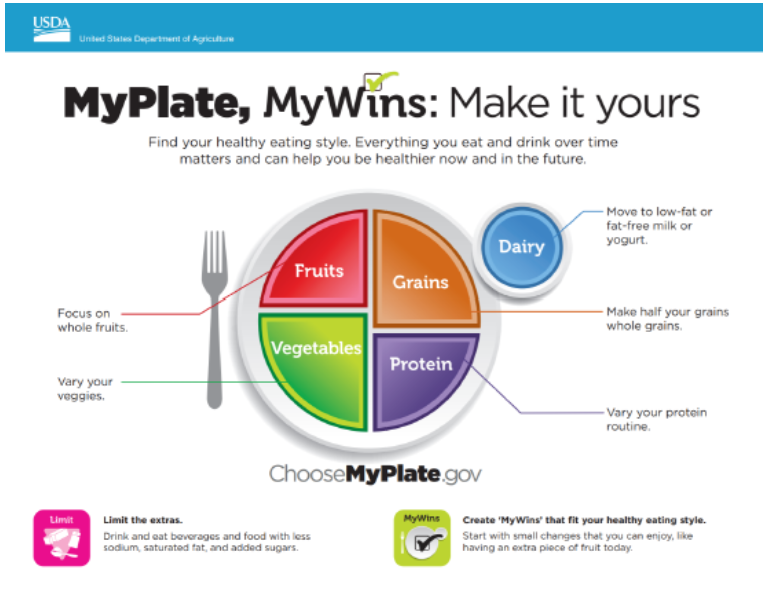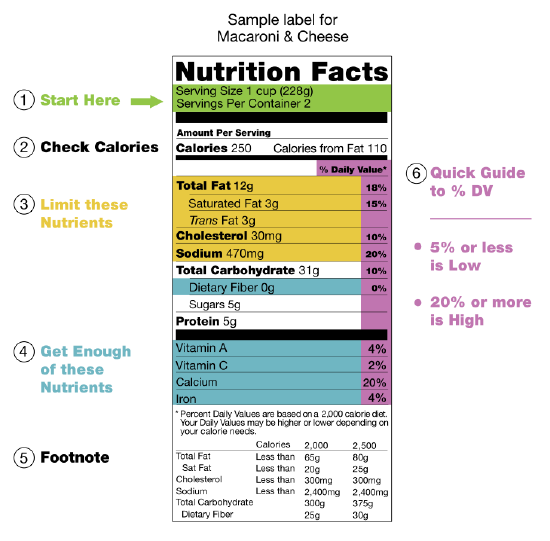7.3: Calories - Quantity and Quality
- Page ID
- 234024
\( \newcommand{\vecs}[1]{\overset { \scriptstyle \rightharpoonup} {\mathbf{#1}} } \)
\( \newcommand{\vecd}[1]{\overset{-\!-\!\rightharpoonup}{\vphantom{a}\smash {#1}}} \)
\( \newcommand{\id}{\mathrm{id}}\) \( \newcommand{\Span}{\mathrm{span}}\)
( \newcommand{\kernel}{\mathrm{null}\,}\) \( \newcommand{\range}{\mathrm{range}\,}\)
\( \newcommand{\RealPart}{\mathrm{Re}}\) \( \newcommand{\ImaginaryPart}{\mathrm{Im}}\)
\( \newcommand{\Argument}{\mathrm{Arg}}\) \( \newcommand{\norm}[1]{\| #1 \|}\)
\( \newcommand{\inner}[2]{\langle #1, #2 \rangle}\)
\( \newcommand{\Span}{\mathrm{span}}\)
\( \newcommand{\id}{\mathrm{id}}\)
\( \newcommand{\Span}{\mathrm{span}}\)
\( \newcommand{\kernel}{\mathrm{null}\,}\)
\( \newcommand{\range}{\mathrm{range}\,}\)
\( \newcommand{\RealPart}{\mathrm{Re}}\)
\( \newcommand{\ImaginaryPart}{\mathrm{Im}}\)
\( \newcommand{\Argument}{\mathrm{Arg}}\)
\( \newcommand{\norm}[1]{\| #1 \|}\)
\( \newcommand{\inner}[2]{\langle #1, #2 \rangle}\)
\( \newcommand{\Span}{\mathrm{span}}\) \( \newcommand{\AA}{\unicode[.8,0]{x212B}}\)
\( \newcommand{\vectorA}[1]{\vec{#1}} % arrow\)
\( \newcommand{\vectorAt}[1]{\vec{\text{#1}}} % arrow\)
\( \newcommand{\vectorB}[1]{\overset { \scriptstyle \rightharpoonup} {\mathbf{#1}} } \)
\( \newcommand{\vectorC}[1]{\textbf{#1}} \)
\( \newcommand{\vectorD}[1]{\overrightarrow{#1}} \)
\( \newcommand{\vectorDt}[1]{\overrightarrow{\text{#1}}} \)
\( \newcommand{\vectE}[1]{\overset{-\!-\!\rightharpoonup}{\vphantom{a}\smash{\mathbf {#1}}}} \)
\( \newcommand{\vecs}[1]{\overset { \scriptstyle \rightharpoonup} {\mathbf{#1}} } \)
\( \newcommand{\vecd}[1]{\overset{-\!-\!\rightharpoonup}{\vphantom{a}\smash {#1}}} \)
\(\newcommand{\avec}{\mathbf a}\) \(\newcommand{\bvec}{\mathbf b}\) \(\newcommand{\cvec}{\mathbf c}\) \(\newcommand{\dvec}{\mathbf d}\) \(\newcommand{\dtil}{\widetilde{\mathbf d}}\) \(\newcommand{\evec}{\mathbf e}\) \(\newcommand{\fvec}{\mathbf f}\) \(\newcommand{\nvec}{\mathbf n}\) \(\newcommand{\pvec}{\mathbf p}\) \(\newcommand{\qvec}{\mathbf q}\) \(\newcommand{\svec}{\mathbf s}\) \(\newcommand{\tvec}{\mathbf t}\) \(\newcommand{\uvec}{\mathbf u}\) \(\newcommand{\vvec}{\mathbf v}\) \(\newcommand{\wvec}{\mathbf w}\) \(\newcommand{\xvec}{\mathbf x}\) \(\newcommand{\yvec}{\mathbf y}\) \(\newcommand{\zvec}{\mathbf z}\) \(\newcommand{\rvec}{\mathbf r}\) \(\newcommand{\mvec}{\mathbf m}\) \(\newcommand{\zerovec}{\mathbf 0}\) \(\newcommand{\onevec}{\mathbf 1}\) \(\newcommand{\real}{\mathbb R}\) \(\newcommand{\twovec}[2]{\left[\begin{array}{r}#1 \\ #2 \end{array}\right]}\) \(\newcommand{\ctwovec}[2]{\left[\begin{array}{c}#1 \\ #2 \end{array}\right]}\) \(\newcommand{\threevec}[3]{\left[\begin{array}{r}#1 \\ #2 \\ #3 \end{array}\right]}\) \(\newcommand{\cthreevec}[3]{\left[\begin{array}{c}#1 \\ #2 \\ #3 \end{array}\right]}\) \(\newcommand{\fourvec}[4]{\left[\begin{array}{r}#1 \\ #2 \\ #3 \\ #4 \end{array}\right]}\) \(\newcommand{\cfourvec}[4]{\left[\begin{array}{c}#1 \\ #2 \\ #3 \\ #4 \end{array}\right]}\) \(\newcommand{\fivevec}[5]{\left[\begin{array}{r}#1 \\ #2 \\ #3 \\ #4 \\ #5 \\ \end{array}\right]}\) \(\newcommand{\cfivevec}[5]{\left[\begin{array}{c}#1 \\ #2 \\ #3 \\ #4 \\ #5 \\ \end{array}\right]}\) \(\newcommand{\mattwo}[4]{\left[\begin{array}{rr}#1 \amp #2 \\ #3 \amp #4 \\ \end{array}\right]}\) \(\newcommand{\laspan}[1]{\text{Span}\{#1\}}\) \(\newcommand{\bcal}{\cal B}\) \(\newcommand{\ccal}{\cal C}\) \(\newcommand{\scal}{\cal S}\) \(\newcommand{\wcal}{\cal W}\) \(\newcommand{\ecal}{\cal E}\) \(\newcommand{\coords}[2]{\left\{#1\right\}_{#2}}\) \(\newcommand{\gray}[1]{\color{gray}{#1}}\) \(\newcommand{\lgray}[1]{\color{lightgray}{#1}}\) \(\newcommand{\rank}{\operatorname{rank}}\) \(\newcommand{\row}{\text{Row}}\) \(\newcommand{\col}{\text{Col}}\) \(\renewcommand{\row}{\text{Row}}\) \(\newcommand{\nul}{\text{Nul}}\) \(\newcommand{\var}{\text{Var}}\) \(\newcommand{\corr}{\text{corr}}\) \(\newcommand{\len}[1]{\left|#1\right|}\) \(\newcommand{\bbar}{\overline{\bvec}}\) \(\newcommand{\bhat}{\widehat{\bvec}}\) \(\newcommand{\bperp}{\bvec^\perp}\) \(\newcommand{\xhat}{\widehat{\xvec}}\) \(\newcommand{\vhat}{\widehat{\vvec}}\) \(\newcommand{\uhat}{\widehat{\uvec}}\) \(\newcommand{\what}{\widehat{\wvec}}\) \(\newcommand{\Sighat}{\widehat{\Sigma}}\) \(\newcommand{\lt}{<}\) \(\newcommand{\gt}{>}\) \(\newcommand{\amp}{&}\) \(\definecolor{fillinmathshade}{gray}{0.9}\)Learning Objective
- Know the daily recommended guidelines to achieve a healthy diet.
The U.S. Dietary Guidelines for Americans and the DRI are important scientific reports to educate health professionals about nutrition and to guide government and other health-related organizations to develop evidence-based health policies that improve the health of all Americans. The United States government has also been providing food and nutrition guidance directly to the public for more than a century to help individuals make healthier dietary and lifestyle choices . You may have heard about "the Four Food Groups" or "The Food Guide Pyramid" or most recently, "My Plate." The government food guidance system has evolved over the years as our understanding of nutrition science and the impact of diet and lifestyle on health has grown.
Web Links
To learn more about MyPlate visit: https://www.choosemyplate.gov/MyPlate
MyPlate
MyPlate is the most up-to-date nutrition teaching tool. MyPlate was developed by the United States Department of Agriculture (U.S.D.A.) Center for Nutrition Policy and Promotion as an easy to use visual guide to help all American develop healthy eating patterns. It replaces the former MyPyramid teaching tool and correlates with the 2015 - 2020 U.S. Dietary Guidelines.
MyPlate organizes foods with similar nutritional value into specific food groups and provides recommendations about how to build a healthy diet. The ChooseMyPlate.gov website also provides a wide range of support materials including information about each food group, an individualized meal planner, recipes and professional videos and handouts such as the MyPlate, MyWins poster shown below to support learning for people of all ages. 
MyPlate Key Messages include:
- Focus on whole fruits
- Vary your veggies
- Vary your protein routine
- Make half your grains whole grains
- Move to low-fat or fat-free milk or yogurt
- Drink and eat beverages and food with less sodium saturated fat and added sugars
- Start with small changes that you can enjoy, like having an extra piece of fruit today
Figure \(\PageIndex{1}\) The ideal healthy plate.
Acceptable Macronutrient Distribution Range
Young men typically have higher nutrient needs than young women. For ages nineteen to thirty, the energy requirements for women are 1,800 to 2,400 calories, and 2,400 to 3,000 calories for men, depending on activity level. These estimates do not include women who are pregnant or breastfeeding, who require a higher energy intake.
AMDR describes the proportions of daily caloric intake that should be carbohydrates, lipids, and proteins. The range in caloric intake in a daily diet should be:
| Macronutrient | AMDR | Additional Information |
| Carbohydrates | 45 to 65 % All age groups | All adults, young and old, should eat fewer energy-dense carbohydrates, especially refined, sugar-dense sources, particularly for those who lead a more sedentary lifestyle. |
| Protein |
10-35% (Adults) 10-30% (4-18 years old) 5-20% ( 1-3 years old) |
The diet should include a variety of lean meat and poultry, eggs, beans, peas, nuts, and seeds. The guidelines also recommend that adults eat two 4-ounce servings (or one 8-ounce serving) of seafood per week. |
| Total Fat |
20-35% (Adults) 25-35% (4-18 years old) 30-40% (1-3 years old) |
|
| Fiber |
22 to 28 grams per day for women and 28 to 34 grams per day for men |
Soluble fiber may help improve cholesterol and blood sugar levels, while insoluble fiber can help prevent constipation. |
Nutrition labels
The nutrition facts label (also known as the nutrition information panel, and other slight variations) is a label required on most packaged food in many countries, showing what nutrients (to limit and get enough of) are in the food. Nutrition facts labels are one of many types of food labels required by regulation or applied by manufacturers. In the United States, the Nutritional Facts label lists the percentage supplied that is recommended to be met, or to be limited, in one day of human nutrients based on a daily diet of 2,000 calories.
With certain exceptions, such as foods meant for babies, the following Daily Values are used. These are called Reference Daily Intake (RDI) values and were originally based on the highest 1968 Recommended Dietary Allowances (RDA) for each nutrient in order to assure that the needs of all age and sex combinations were met.
How to understand and use the US Nutritional Fact Label

A sample nutrition facts label, with instructions from the U.S. Food and Drug Administration. Image by Trounce, Public domain, via Wikimedia Commons
Summary
- MyPlate is the most up-to-date nutrition teaching tool developed by the United States Department of Agriculture (U.S.D.A.) Center for Nutrition Policy and Promotion as an easy to use visual guide to help all American develop healthy eating patterns.
- Planning a healthy diet using the MyPlate approach is not difficult. According to the icon, half of your plate should have fruits and vegetables, one-quarter should have whole grains, and one-quarter should have protein. Dairy products should be low-fat or non-fat.
- There are five key factors that make up a healthful diet namely: a. adequacy, b. balance, c. calorie control, d. moderation, and e. variety.
- The total number of calories a person needs each day varies depending on a number of factors, including the person’s age, sex, height, weight, and level of physical activity.
Sources
- USDA, choosemyplate.gov
- US Department of Health and Human Services, Health.gov
- Wikipedia contributors. (2021, March 14). Nutrition facts label. In Wikipedia, The Free Encyclopedia. Retrieved 20:15, May 17, 2021, from https://en.wikipedia.org/w/index.php?title=Nutrition_facts_label&oldid=1012100208

